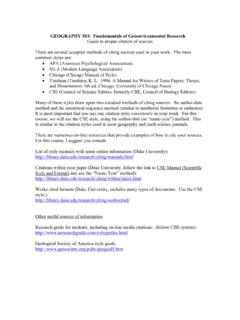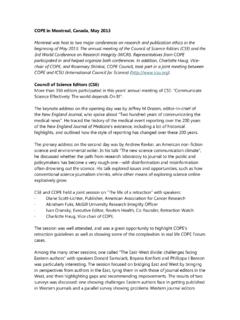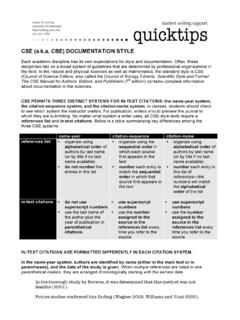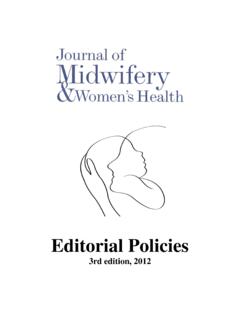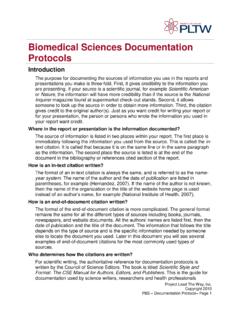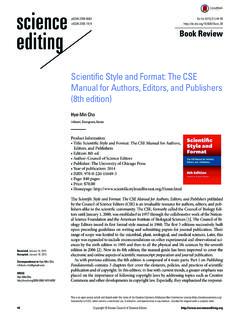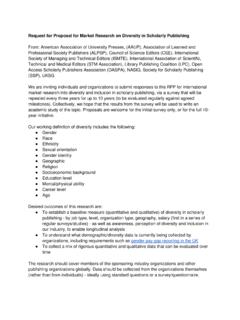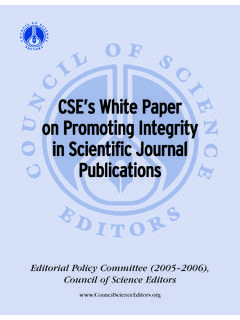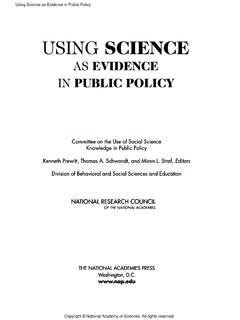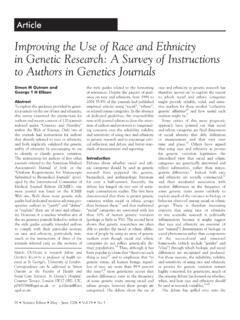Transcription of Council of Science Editors (CSE) Annual Meeting 2015
1 99 November 2015 ; 41(4) European Science EditingThe Council of Science Editors (CSE) Annual Meeting 2015 was held between 15th and 18th May this year in Philadelphia, USA. Dynamic Variables: Solving the New Editing/Publishing Equations was the theme of the Meeting , wisely chosen to reflect the changing nature of the global editing/publishing industry. The Meeting was attended by over 400 CSE members, including manuscript Editors , journal Editors , publishers, scholars, scientists, data professionals, entrepreneurs and software developers, from around the world. The highlights of the conference were the keynote and plenary speeches. The keynote speech by G. Sayeed Chaudhary (Associate Dean for Research Data Management, The Johns Hopkins University) was on The Research Data Revolution. Chaudhary compared the importance and relevance of data to that of oil, equating data conservatories to traditional libraries.
2 He defined preserve, share and discover as the three major principles of data conservation, and listed the four v s of big data: volume, velocity, viscosity and variety. He concluded by highlighting the differences in the way data have been used over the years. In the present day, data are published before analysis, unlike in the past, when data were analysed before publishing. One of the most memorable one-liners from the conference was Chaudhary s statement One person s noise is another person s signal , highlighting how apparently useless data can be useful in someone else s plenary speech The Future of Thought by Clive Thompson, a freelance journalist and columnist for the New York Times Magazine and Wired, was about the changing aspects of communication and how different platforms can be suited for different purposes. Thompson stressed the amount of information available on social media, which may not seem immediately relevant to the consumer.
3 He pointed out that such ambient information can aid peripheral vision. He then went on to elaborate the importance of strong and weak ties, stressing the importance of weak ties in professional career building. He stressed the importance of community data projects (eg Skyrim, Galaxy Zoo, FoldIt) in the current internet generation, and concluded by urging the attendees to choose carefully between what information to share publicly (public thinking) and what not to (private thinking). Considering how entrenched our lives are in social media and the internet, I was very intrigued by Thompson s talk and read his book on the same topic, called Smarter Than You Think: How Technology Is Changing Our Minds for the Better. Similar to the talk, I found the book to be a fascinating read and recommend it meat and potatoes of the conference were the 32 concurrent sessions on various topics, among which I managed to attend eight.
4 On the first day, in the session titled Different Forms of Peer Review conducted by Adam Etkin (Pre-Val), Jody Plank (Rubriq) and Chi Van Dang, the speakers spoke about the necessity of an honest and ethical peer review. The driving message was that all research needs validation, with peers being the best at doing it, especially in the age of citation cartels and predatory publication. They discussed peer-review validation services such as Pre-Val, which provide an automated validation of the validation process, extract data from the journals existing peer-review framework as well as verify it and provide the results in a user-friendly session By the Numbers: Evaluation Strategies to Improve Journal Performance was conducted by Etta Kavanagh (Proceedings of the National Academy of sciences ), Alexis Wynne Mogul (KWF Editorial Services), Christina Nelson (Journal of Bone and Joint Surgery; JBJS), Jonathan Schultz (Circulation Research) and Marc F Swiontkowski, MD (JBJS).
5 The speakers discussed aspects of journal performance such as reviewing reviewers, emphasizing the balance between selection and deselection, creation of rubrics based on rejection rates and the nature and detail of comments and incentives such as reviewer recognition programmes. They highlighted the need for comprehensive reports, including positive feedback as well, along with need-based reviewer training. With regard to editor monitoring, the speakers spoke about working toward a global journal vision and creating attainable goals to carry the vision forward. On the aspect of time tracking for quantifying staff performance, the advantages of cloud-based tracking for uniform organization-wide tracking, quantitative reports, need-based training time optimization were stressed. In the session Preparing a Manuscript when English is a Second Language (ESL) conducted by David I. Hanauer, Donald Samulack (Editage) and Jeri Marie Wright (Public Library of Science ; PLOS), the speakers stressed on increased anxiety, reduced satisfaction and increased difficulties that ESL authors face while attempting to publish in English.
6 One of the interesting points in the session was the stress on the need for educating authors because of the current English or Perish situation in academic publishing. The speakers highlighted the need for educating ESL authors stems from their fundamental challenges in expression, difficulty in quoting and paraphrasing, lack of mentorship and younger age of graduation. In addition, they discussed the role of specialized journals catering to ESL authors ( PLOS Neglected Tropical Diseases), which provide a larger stage for publication of the research of these session Communicating with Readers and Engaging Them Through the Use of Technology conducted by Patty Baskin (Neurology), Sheehan Misko (AACC) and Ingrid Philibert (Journal of Graduate Medical Education; JGME) stressed the need for journals to change their strategies to increase readership, increase the practical use of journal contents and serve different groups of readers with different needs.
7 JGME, for example, started online journal clubs (with a blog, discussion forums, an active Twitter presence, Google Hangouts) and became active on community- Council of Science Editors (CSE) Annual Meeting 201515 18 May 2015 , Philadelphia, USAE uropean Science Editing100 November 2015 ; 41(4) specific social media sites (MedStro). With regard to reinventing journals, they presented the example of Clinical Chemistry changing from being a print-only journal to an interactive online journal focusing on trainee clinical chemists, including video posts, podcasts and journal clubs. Neurology journals, on the other hand, added content to improve online readership (supplemental content, links to errata, retractions, PubMed referrals, topic collections, and personal folders), started spin-off journals, made optimized mobile versions and designed apps for Android and iOS, along with continuing medical education modules and the second day, in the session Assessing a Journal s Impact: Article-Level Metrics and Our Editorial Services conducted by Christine Casey (Center for Disease Control and Prevention), Kerry Kroffe (PLOS One) and Christina Mills (MEDICC), the speakers discussed the advantages of article-level metrics and features such as the ALM Suite and ALM reports.
8 They discussed the challenges faced in assessing the journal impact, including accuracy of data, need for structured meta-data and other information such as funder/institution information. Long-term solutions discussed included authentication of author information (eg ORCID), authentication of funding information (eg FundRef) and institutional identifiers (Ringgold).In the session on Peer Review Ethics: Do Journals need to Ensure that Reviewers Behave, Carol Carr (Organic Letters), Ivan Oransky (Retraction Watch) and Darren B. Taichman (Annals of Internal Medicine) spoke about the importance of sensational and subtle manipulations of the peer review system, especially considering the increasing incidence of breaches of ethical conduct in scholarly publishing. The major issues discussed included sharing or using research information for personal gain, unfair scientific standards, breach of confidentiality and author slandering.
9 They discussed the importance of institutions such as Committee on Publication Ethics (COPE), CSE and International Committee of Medical Journal Editors (ICMJE) for ensuring the fairness of reviews. Suggested measures included prompt grading of reviews (rewarding good practices and penalizing the bad ones), active policing, screening and certifying reviewers and ensuring signed session Self-Publishing or Contract Publishing: Understanding the Advantages was moderated by my colleague Donald McClain (Enago). The speakers Audra E. Cox (American Society for Investigative Pathology), Cara Kaufman, (Kaufman Wills Fusting & Company), Judie Lieu (The Gerontological Society of America) and Ann Murphy (AlphaMed) discussed the various aspects of the current publishing models. In addition, the advantages and potential disadvantages of self-publishing or contract publishing were discussed in detail, for a better understanding as to which model might work best for a particular situation.
10 The speakers also answered questions regarding the transition between the models. In the last session of the conference titled Understanding Impact: The Journal Impact Factor and Beyond, the speakers Betsy Donohue (Digital Science ), Adam Etkin (Pre-Val) and Joelle Mascuilli (Thomson Reuters) discussed various aspects of the present state of impact factor. The consensus was that there is nothing inherently wrong with impact factor, but there were issues in the way it is being used. The speakers pointed out that most of the current scholarly indicators are all lagging metrics and that the best metrics guide us regarding decision-making. The conclusion was that apart from metrics, factors such as peer review must be considered while discussing journal short courses were also on offer in the first two days of the conference, including those for journal Editors and manuscript Editors and those on publication management and journal metrics.
